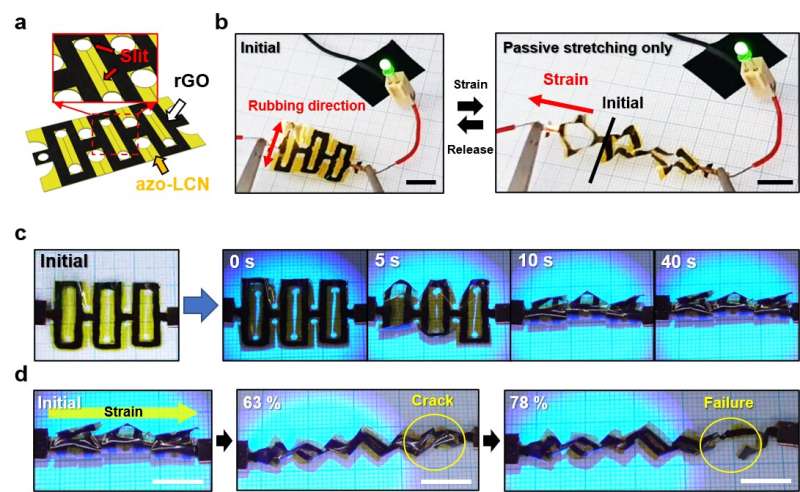3D shape reconfiguration of stretchable electronics

Azobenzene functionalized liquid crystalline polymers are considered "smart" materials owing to their programmable shape transformations under various external stimuli (i.e., thermal, chemical, and photomechanical shape morphing). In particular, their light responsivity allows for untethered powering and actuating systems. Now, researchers from Inha University have demonstrated preparation and actuation of reduced graphene oxide patterned azo-LCN (azo-LCN/rGO) with highly enhanced elastic modulus, electrical conductivity, and photomechanical actuation performance.
In their studies, they evaporated the GO solution on a masked glass slide and obtained an rGO pattern through a reduction process. The rGO-patterned glass cell is achieved by attaching a mechanically rubbed, polyamide-coated glass slide on the rGO-patterned glass slide with a spacer. In the glass cell, liquid crystalline monomers are injected and photopolymerized. During photopolymerization, the rGO pattern on the glass cell was successfully transferred to the azo-LCN due to the large number of π-π interactions between the rGO and benzene moiety of azo-LCN, providing an effective stress transfer at the interfaces; this, in turn, causes a highly enhanced modulus. The modulus and electrical conductivity could be tailored by simply adjusting the number of rGO coating cycles. After repeating the rGO coating process four times, the modulus and electrical conductivity of the azo-LCN/rGO reached 6.4 GPa and 380 S cm-1, respectively.
Under UV irradiation, the rigid azo-LCN/rGO demonstrated higher bending actuation than the softer neat azo-LCN. On top of the photochemical trans-cis isomerization of the azobenzene moiety, the coefficient of thermal expansion (CTE) mismatch between the azo-LCN and rGO generated by photothermal temperature rises, inducing higher bending actuation of the azo-LCN/rGO. Hence, the rGO patterned geometry of azo-LCN/rGO helps overcome the trade-off relationship between stiffness and actuation strain. The azo-LCN/rGO also showed multi-stimuli responsivity because of the broad absorption band of the rGO and the anisotropic thermal contraction/expansion of the azo-LCN. Near infrared (NIR) light, focused sunlight, and the flame of a portable lighter can be employed for actuation of the azo-LCN/rGO.
Finally, Inha researchers have introduced "kirigami-engineered azo-LCN/rGO" with higher degree of freedom in regards to actuation beyond the strain capacity of the material. Upon exposure to UV, the kirigami-engineered azo-LCN underwent active type 3D shape reconfiguration without deterioration of electric performance under passive type mechanical stretching. The researchers have expanded the principles of passive type strain responsive stretchable electronics to a dual-stimuli responsive shape reconfiguration by a demonstration of the kirigami-engineered azo-LCN/rGO, which evinces highly enhanced mechanical strength, electrical conductivity, and actuation performance.
More information: Woongbi Cho et al, Photo‐Triggered Shape Reconfiguration in Stretchable Reduced Graphene Oxide‐Patterned Azobenzene‐Functionalized Liquid Crystalline Polymer Networks, Advanced Functional Materials (2021). DOI: 10.1002/adfm.202102106
Journal information: Advanced Functional Materials
Provided by Inha University





















